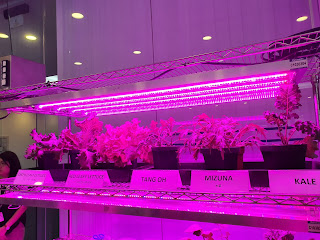Visited the Panasonic Factory Farm organised by SFA and Geog unit after the Full Geography Seminar.
It is the 1st farm which has both the farm license and food processing licence. We were shown a video on the indoor farm as well as how to use a veggie life cultivation kit and reminded not to put the seeds too deep into the soil, not more than 10 cm. It will take around 35 days to mature as compared to the traditional farms' which take a longer growing period of 6 weeks to 2 months. If school wants can contact by SFA online at $10 per participant. Each participant will be given the veggie life cultivation kit and a bowl of salad. I must really say the salad was so crunchy and delicious as it's fresh from the farm! More exotic japanese plants were grown in the factory farm which is 30% cheaper than imported. Our guide explained to us why red and blue lights are used. For photosynthesis, red light control a parameter and blue another. The amount of light used is customised to the plant grown. There is also control of water and nutrient as well as enhanced co2. Same music is played (mainly classical) to encourage plant growth. Air flow/wind is used to toughen the plant.
Some are planted in peat from European countries
And some using Hydroponics. Some are hybrids. We
We saw from the monitor the prep room, harvesting room and Processing room.
With the controlled production, there is a stable supply and there is quality assurance and no pesticides is used as no pest can enter. It has a Shorter lead time and is not at mercy of adverse weather and not affected by price fluctuations.
There is also increase productivity with the use of automation for example, 11 instead of 27 labour is needed.
Though investment cost is higher for hydroponics, operation cost (less labour) is lower. Hydroponics technology is more matured compared to aeroponics and aquaponics. Moreover, Aquaponics has high risk.
Panasonic sees food production as part of corporate social responsibilty contributing to food security. Our guide mentioned that the biggest challenge is consumer education as it is more costly for indoor produce.
In Singapore, 90% of the vegetgables are imported as the vegetables are cheaper due to economies of scale. For local produce, other than government support, consumer support is definitely needed as when there is more demand and more are produced, the cost can be reduced.
https://www.panasonic.com/sg/corporate/news/article/singaporeindoorfarm.html














No comments:
Post a Comment